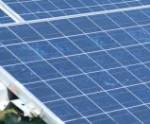The National Renewable Energy Laboratory (NREL) has determined solid figures regarding the land use requirements of solar farms per annual gigawatt hour of power produced.
Based on data from 72% of the solar farms operational or under construction in the USA, the NREL has concluded small single-axis solar panel systems require on average 2.9 acres per annual gigawatt-hour – or 3.8 acres taking into account all the unused land falling inside the area. For a large fixed tilt photovoltaic (PV) plant generating the same amount annually, 2.8 acres of solar panels are required on average.
A previous NREL report estimated that if solar energy was to meet 100% of all electricity demand in the US, it would occupy 0.6% of the nation’s total area. Other studies have provided similar figures on a global scale.
While the numbers may sound large, NREL points out utility-scale PV in the U.S. Southwest requires less land than the average U.S. power plant using surface-mined coal.
The NREL report, “Land-use Requirements for Solar Power Plants in the United States,” (PDF) can be viewed here.
Massive ground-mount solar farms may be exciting and certainly play an important role in a clean energy future, but even more exciting is the still-untapped potential of the sea of solar panel-less rooftops that can be found in any nation.
Even with Australia’s incredible uptake of solar power systems, millions of suitable residential and commercial rooftops across the country are still waiting to be turned into power stations. This is primo solar electricity generating real estate being neglected; space that does not have to be appropriated or developed.
Rather having a gargantuan solar farm often cranking power many kilometres from the point of end user consumption; solar panels on a rooftop also address a very important related issue – line loss. The nature of power transmission is such that the further away electricity is generated, the more is lost in transit – usually through heat. Line loss accounts for up to 10% of power production.
The benefits of distributed generation on a small scale are many – including reducing the need for additional infrastructure and small scale systems have also helped rein in wholesale electricity prices in Australia.
Except in the case of community owned solar farms, it could also be said privately owned rooftop installations generally better represent the concept of “power to the people, by the people, for the people”.












































